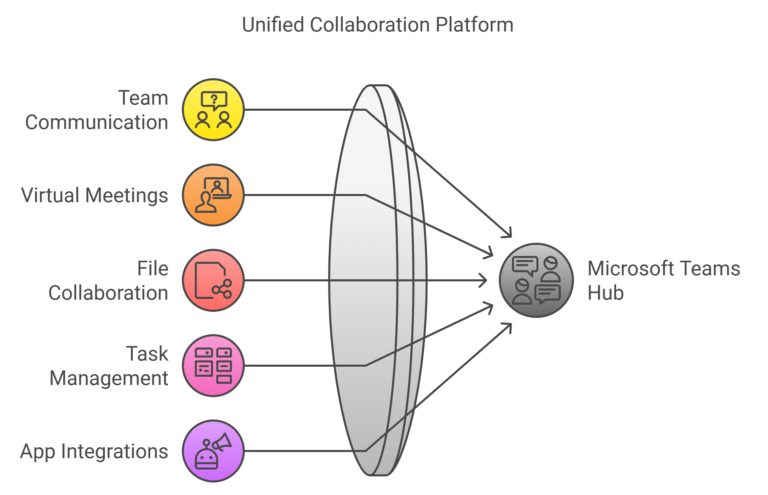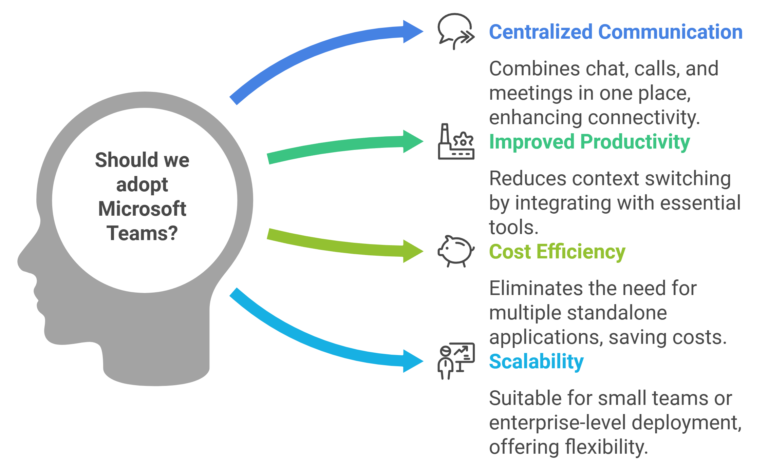
What is Microsoft Teams? What is it and What is it For?
Microsoft Teams has emerged as one of the leading collaboration tools in the workplace, transforming how teams communicate and collaborate.
This cloud-based application is part of the Microsoft 365 suite, offering a centralized platform for chat, video meetings, file sharing, and integrations with other Microsoft and third-party tools.
In this article, we delve into what Microsoft Teams is, its key features, and how it integrates with SharePoint, including the latest updates.
What is Microsoft Teams?
Microsoft Teams is a collaboration and communication platform designed to simplify teamwork by consolidating various functionalities. It enables users to engage in real-time conversations, conduct virtual meetings, and manage projects seamlessly.
Teams is widely used by businesses, educational institutions, and organizations of all sizes to streamline workflows and enhance productivity.
What is Microsoft Teams Used For?
Microsoft Teams serves as a hub for teamwork, bringing together tools and services required for effective communication and collaboration. Key purposes of Microsoft Teams include:

- Team Communication: With its chat-based interface, Teams facilitates real-time messaging, including private chats and group discussions.
- Virtual Meetings: It supports high-quality video and audio conferencing, suitable for one-on-one meetings, webinars, or large-scale events.
- File Collaboration: Teams integrates with OneDrive and SharePoint, allowing users to store, access, and edit files directly within the platform.
- Task Management: With tools like Planner and To Do, users can assign tasks, set deadlines, and track progress.
- App Integrations: Teams integrates seamlessly with over 700 apps, including Microsoft Office tools like Word, Excel, and PowerPoint, as well as third-party applications like Trello and Zoom.
Important Features of Microsoft Teams
Microsoft Teams is feature-rich, designed to support diverse business needs. Below are its standout functionalities:
1. Channels and Teams
- Channels: Dedicated spaces within a Team for organizing conversations and resources by topic or project.
- Private Channels: Restrict access to specific members for sensitive discussions.
2. Video and Audio Conferencing
- Host secure, high-quality video meetings with up to 1,000 participants.
- Offers breakout rooms, live captions, and recording options.
- AI-powered noise suppression ensures better audio quality.
3. Chat and Messaging
- Persistent, searchable chat history.
- Rich formatting options, including emojis, GIFs, and message reactions.
- Support for threaded conversations in channels.
4. File Sharing and Collaboration
- Share files directly in chat or channels.
- Co-authoring capabilities enable real-time editing in Microsoft Office documents.
- Files are securely stored in SharePoint, with version history for tracking changes.
5. App Integrations
- Extensive app library, including connectors for CRM tools, project management apps, and bots.
- Custom app development using Power Platform.
6. Security and Compliance
- Built-in enterprise-grade security with end-to-end encryption.
- Compliance with global standards, including GDPR, HIPAA, and ISO 27001.
What’s New in Microsoft Teams?
The latest updates introduced at Microsoft Ignite 2024 showcase Microsoft’s commitment to enhancing user experience and functionality. Some of the key updates include:

1. Teams 2.0
- A revamped Teams experience offering twice the performance with half the system resource usage.
- Faster meeting joins and optimized load times.
2. Collaborative Notes
- A new feature allowing shared meeting notes, agenda creation, and action items in real time.
- Synchronizes automatically with Microsoft Loop components.
3. Copilot for Teams
- AI-powered Copilot assists with summarizing conversations, suggesting replies, and creating drafts for chats and emails.
- Improved decision-making by providing real-time insights from ongoing meetings.
4. Enhanced Meeting Rooms
- Integration with intelligent cameras for tracking speaker movements.
- Advanced whiteboard tools and touch-enabled devices for interactive sessions.
5. Green Rooms for Presenters
- A backstage area for presenters to prepare before going live.
- Includes tools for rehearsals, reviewing slides, and private chats with co-presenters.
Advantages of Microsoft Teams Over Competitors
- Tight Microsoft 365 Integration: Unlike standalone platforms, Teams integrates seamlessly with tools like Outlook, SharePoint, and OneDrive.
- Highly Scalable: Suitable for small teams and large enterprises alike.
- Frequent Updates: Microsoft consistently enhances Teams with new features and improvements.
How to Get Started with Microsoft Teams
- Sign Up: Create an account using your Microsoft credentials.
- Set Up Teams: Organize teams and channels based on projects, departments, or functions.
- Explore Features: Utilize video conferencing, chat, and file-sharing tools.
- Integrate Apps: Enhance productivity by integrating third-party apps.
Why Should Your Organization Use Microsoft Teams?
Adopting Microsoft Teams offers numerous benefits, including:

- Centralized Communication: Combines chat, calls, and meetings in one place.
- Improved Productivity: Reduces context switching by integrating with essential tools.
- Cost Efficiency: Eliminates the need for multiple standalone applications.
- Scalability: Suitable for small teams or enterprise-level deployment.
- User-Friendly Interface: Easy to adopt and navigate, ensuring quick onboarding.
Conclusion
Microsoft Teams continues to revolutionize how organizations collaborate by offering a robust, scalable, and secure platform. With its advanced features and seamless SharePoint integration, Teams is an indispensable tool for businesses aiming to enhance efficiency and communication.
Whether you are managing projects, hosting meetings, or automating workflows, Microsoft Teams provides a comprehensive solution tailored to your needs.










Permalink
Permalink